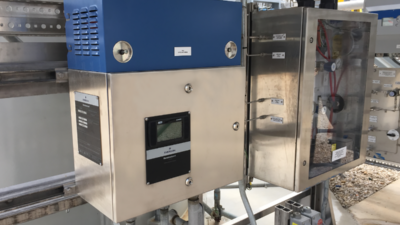Considering lifecycle costs for automation system technologies can help the bottom line by reducing power consumption, raw material costs, and personnel requirements and increase production through better asset utilization, according to Bottom-Line Automation, a book by Peter Martin. Among examples are the improvements seen in field instrumentation over the past 30 years.
KEY WORDS
Process control and instrumentation
Pressure sensing
Pressure transmitters
Instrument calibration and maintenance
Considering lifecycle costs for automation system technologies can help the bottom line by reducing power consumption, raw material costs, and personnel requirements and increase production through better asset utilization, according to Bottom-Line Automation , a book by Peter Martin.
Among examples are the improvements seen in field instrumentation over the past 30 years. These improvements have had a direct impact on plant efficiency through increased performance. Less used, however, are the ‘new best practices’ these improvements have enabled.
Key transmitter attributes that have evolved over the past 30 years include:
Performance;
Reliability;
Intelligence;
Flexibility; and,
Scalability.
Enhancements to these device parameters continue to improve device capabilities and, more importantly, enable new opportunities for users. Transmitter improvements have allowed users to challenge existing practices for device installation, maintenance, and specification.
Implementing best practices
Most plants operate with reactive or preventive maintenance approaches that do not take advantage of improvements in smarter and better devices. Use of new best practices for field-device selection, installation, and maintainability will reduce time and cost while improving operations and process availability.
One example of what can be achieved with today’s microprocessor-based transmitters is that users can streamline calibration procedures, extend the frequency between calibrations, and perform transmitter validation vs. calibration. Improvements in device performance, stability, and reliability have all experienced nearly 10-fold improvements over the past 30 years.
Decrease in percent of span error and increase in field reliability has generally kept pace with increases in installed pressure transmitter base over the last 30 years.
Principles that are helpful to consider before implementing new best practices include:
Take a technician’s point-of-view to minimize risk and costs due to service and repairs;
Focus on life-cycle costs vs. short-term capital project costs (i.e., engineering has it for a year, but maintenance has to live with it for 20 years); and
Consider maintainability (i.e., time and resources necessary to restore or keep equipment in a specified operational condition) as a key factor in instrumentation life-cycle costs.
Reducing work orders
Many plant managers would like to move away from reactive/preventive operations towards predictive maintenance and spend maintenance dollars only on equipment that requires it. Results are quantifiable because of a finite number of primary causes for pressure transmitter work orders. Nearly two-thirds (63%) of pressure transmitter work orders are routine instrument checks or ‘no problem found.’ Technology improvements over the last generation of devices have made inroads on many remaining maintenance operations.
The challenge for maintenance departments is first to understand if technology improvements can eliminate the necessity for many of requests for work orders. The second challenge is determine what practices will change to exploit these technology improvements.
Routine checks and ‘ghost trips’ account for nearly two-thirds of pressure transmitter work orders. These two areas represent the ‘low-hanging fruit’ opportunities to reduce maintenance time and cost.
Routine checks
An instrument’s drift specification is an indication of how often adjustments need to be made to maintain that device. Transmitter calibration checks are performed periodically, typically ranging from once every six months to yearly. These standards are based upon the typical transmitter drift specifications of devices from the 1980s. These ‘historic’ standards have been challenged by transmitter improvements that now routinely offer ten-fold stability improvements over earlier devices.
Calibration or validation frequency required for a typical transmitter for an application that requires less than 0.4% of span error drops off sharply as instrument stability increases. Here a ‘smart’ transmitter is compared to the latest ‘state of the art’ technology.
Determining appropriate transmitter calibration frequency requires that special application requirements such as safety, custody transfer agreements, etc., be considered. Note that ISO 9000 certification does not mandate frequency of calibration. It only mandates proper documentation and adherence to established calibration practice. To determine the proper calibration frequency and documentation, consider two criteria: accuracy requirements of the application and installed performance and stability of the transmitter.
By comparing the application performance requirements against the installed performance of the transmitter, the calibration or validation interval is determined. For simple evaluation of transmitter calibration frequency, software tools are available from suppliers that allow users to quantify installed repeatability over time for specific transmitters in specific, user-defined applications.
No problem found
A proven methodology to reduce the frequency of ‘ghost trips’ is through predictive maintenance or Equipment Health Monitoring (EHM) versus preventive maintenance. To illustrate the value of EHM, consider the ‘nail in the tire’ analogy. A nail in a car tire will, if undetected, eventually cause a blowout, potentially leading to an accident. Fixing the car after the accident-reactive maintenance-can be very expensive. Preventive maintenance requires the user to inspect the tires before every trip to check for an embedded nail. This can be very time consuming, as most inspections may not reveal a nail. Also, these inspections will not prevent the accident if a nail pierces the tire shortly after the car leaves the driveway.
The majority of work orders written for pressure tranmitters fall under routine checks or result in ‘no problem’. Many common maintenance has been eliminated by technology improvements over the last three decades.
What’s needed is predictive maintenance -in other words, ignore the tire until and unless it alerts you that it has a nail in it. It should be obvious that this approach minimizes maintenance labor and the risk of accident. So, why doesn’t every car have a ‘nail in tire’ light on its dashboard? For both tires and transmitters, a key enabler for predictive maintenance is suitable diagnostics.
Recent transmitter technology enhancements now make this feasible by enabling transmitter health diagnostics and advanced process diagnostics. A typical ‘smart’ transmitter, for example, has a microprocessor with access to over 100 device parameters. Field technicians have access to these diagnostic parameters remotely or locally through handheld communicators. Technicians may also access the device remotely without leaving the maintenance shop with asset-management software.
There is a wide range of relative maintenance costs depending on the type of program used. Preventive maintenance can be five times more expensive than predictive maintenance because of unnecessary maintenance. However, reactive maintenance can be as much as 15 times more expensive than predictive maintenance, since waiting for a device to fail can be extremely costly. And finally, if a failure impacts process operations, the cost can be as much as 40 times the cost of predictive maintenance. Accordingly, predictive maintenance is by far the most cost-effective methodology for maintaining instrumentation. Built-in transmitter diagnostics is the key enabler for implementing these practices.
Calibration problems
Pressure transmitter calibration shifts primarily result from analog component drift or unnatural events, such as over-pressuring the sensor. All instrumentation is subject to analog component drift, due to environmental effects (heat, moisture, etc.) on the electronics. Newer transmitters have been made more robust through innovative electronics packaging. Hermetic sealing of electronics and sensor modules has done much to protect them from harsh plant environments. This alone has improved instrument reliability, robustness, and reduced transmitter drift, making possible long term (up to 10-year) stability under actual process conditions.
The relative costs of different maintenance can effect plant bottom line. Newer transmitter technologies allow migration toward the predictive model of instrument maintenance.
Typical transmitters today are usually mounted at grade, 10-15 ft from the primary element. Impulse lines connect the primary element and transmitter. There are no set installation standards; each application is unique. Because the resulting lines have unique geometry, mounting transmitters at grade requires extra valves, tracing, supports, and insulation, which also add installation cost. Impulse lines are a source of inaccuracy and variability. Even when new clean impulse lines are used to connect a differential pressure transmitter to a process, errors are introduced that will be measured (quite accurately) by the pressure transmitter. Compensating for these errors is difficult, since installations vary depending on the application and technician. Compromises in isolation schemes and temperature conditions also affect accuracy and can lead to plugging and failure.
Most transmitters been mounted at grade for accessibility and because that’s the way it’s always been done. At-grade installation increases initial and maintenance costs.
Over the past decade, significant progress in transmitter design has been made to enable direct mounting. For example, long-term guaranteed stability, improved reliability, self-checking diagnostics with remote access, and features such as remote displays and interfaces, have made direct mounting practical. The instrument no longer needs to be readily accessible. Installation cost and componentry are less.
Picking a supplier
A reliable transmitter reduces maintenance costs through reduced work orders, but less obvious is how to benchmark or quantify a product’s reliability. Look for robust transmitter design, supplier quality control (well documented and statistically sound analysis including third-party Failure Modes, Effects and Diagnostic analysis, accelerated life simulation, and MTBF analysis), supplier experience (size of installed base), and history of continuous improvements to reliability.
A reliable benchmark for evaluating device quality is mean-time-between-failure (MTBF) data. MTBF is defined as a measure of random constant failures that are not reducible through material selection or routine maintenance, which affect only the wear-out failure modes. MTBF is not a measure of how long a device will function under field conditions.
If MTBF is a measure of random failures, product robustness is a measure of how a device performs to unplanned or abnormal events. Often, product robustness is used to describe the installed reliability of an instrument. A simple predictor of installed reliability is experience. Feedback and opportunity for improvement of a supplier is a function of size of the installed base and the variety of applications served-a simple learning curve.
Favoring maintainability
Besides robustness and reliability, other elements need to be considered when picking pressure transmitters. These can include:
Modular software design. Nothing remains static in a process plant-failure to leverage an expandable intelligence platform may create a system that is easy to work on today, but is impractical tomorrow. A key requirement for instrumentation software is communication flexibility, which enables advanced measurement diagnostics and enhanced measurement capabilities. Inclusion of easy and cost-effective upgrades to FOUNDATION fieldbus protocol and a pathway for device upgrade to wireless communication or web-based communication are useful features.
Standardization of materials. Standardization enables users to reduce mean-time-to-repair (MTTR) process loop devices. Pressure transmitters are used in nearly 50% of flow and vessel applications since transmitters are typically the most reliable technology and can be isolated from the process for maintenance. If a failure occurs, standard transmitters can be replaced and the process loop brought back on-line quickly.
Therefore, process loops using transmitters typically should have the highest MTBF and the lowest MTTR. Specific to the transmitter, MTTR is based on the flexibility of the transmitter design for complete interchangeability of parts. Estimated MTTR for a single transmitter should be less than one hour.
Technology in pressure transmitters and other field instrumentation has enabled new opportunities to help the bottom line. Use of new best practices allows a plant to reduce total installed costs, maintenance costs, and improve plant efficiency and availability.
For more information go on line at www.controleng.com/freeinfo , or visit www.emersonprocess.com .
Additional Resources
For more reading on this topic, see:
Accounting needs will renew industrial technology investments
Pressure Sensing: It’s Everywhere!
Author Information
Eric Wickberg is manager of pressure applications and Tim Twining is senior applications engineer for Emerson Process Management, Rosemount Measurement Div.



